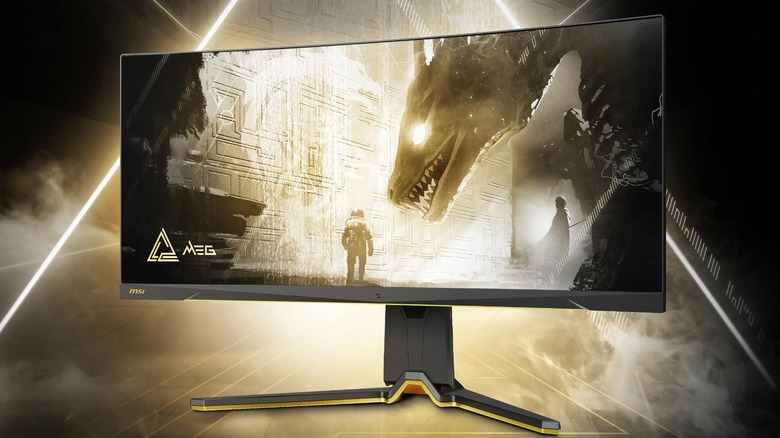Major PC Monitor Brands Ranked Worst To Best
Whether you're looking for a second display for your laptop, an expansive display for a desktop PC, or a high-speed display for serious gaming, choosing the right monitor can be a challenge. With so many brands available, and each with a broad selection of displays, it's often hard to know which way to go.
Even if you're just looking for a basic display for work, it's important to consider factors like reliability, warranty coverage, and compatibility. Those are even more serious factors if you're planning to spend more on a higher-end monitor for graphics production or gaming.
Then there's the question of what your future needs will be. Even the most affordable monitors can last you for years, so it's worth thinking ahead so you're not forced to buy a new display down the road because your current one is still working fine but simply doesn't meet your needs.
Needless to say, there's a lot to think about when choosing a new monitor for your PC, but you can narrow down your options by understanding how the different brands compare to each other. Most of these brands have a variety of displays that will meet just about anyone's needs, but they're not all created equally, and they each excel in different areas. Here are nine of the most well-known display makers, ranked from worst to best.
9. MSI
MSI makes some of the best affordable gaming laptops, so it's probably no surprise that it makes some decent gaming monitors, too. However, while gaming monitors already serve a relatively narrow audience, MSI takes that even further, with a razor-sharp focus on delivering ultrafast refresh rates. Its Oculux series esports lineup has some of the fastest refresh rates on the market, but it does so at the expense of advanced picture quality settings and the extended color gamuts offered by many of its similarly-priced competitors.
Some of MSI's more recent Optix gaming monitors have adopted the wider DCI-P3 color gamut, which looks great for HDR games, but they sacrifice the standard sRGB mode to do so, which can make things look oversaturated for everyday use.
MSI's displays also tend to be more bare-bones than the competition when it comes to extra features. For instance, many lack the built-in speakers and USB ports that are standard features for displays from many other companies.
8. Gigabyte
Gigabyte isn't a household name like many of its rivals, but it does offer a good lineup of quality displays under both its own name and the Aorus brand. While Gigabyte designates many of its displays as gaming monitors, nearly all of them are versatile enough to be used as your everyday work monitor as well.
The Aorus lineup sits at the higher end. Like MSI's gaming monitors, they focus on very fast refresh rates but do so at the expense of other important features like color accuracy, despite being on the pricier end of the spectrum.
The standard lineup of Gigabyte-branded M Series monitors is more well-rounded and delivers better value, with at least one earning an honorable mention on our list of affordable gaming monitors. They also feature an integrated KVM switch that lets you switch between two sources, such as your work laptop and gaming PC, using the same keyboard and mouse to control either.
7. ViewSonic
ViewSonic makes some of the most budget-friendly monitors you'll find, especially for gamers. Its products are a good pick if you're looking for something that will go easy on your wallet, but for higher-performance options, you may be better off looking elsewhere.
While most of ViewSonic's monitors are very affordably priced, the company also offers a higher-end gaming lineup in the form of its Elite series of monitors that feature fast refresh rates and good color quality. These come in at the other end of ViewSonic's price range, and while they compare favorably with rival gaming monitors in the same class, they're overkill for everyday use.
The Elite series also doesn't offer as wide a selection in comparison to other display makers. ViewSonic's more affordable Omni models actually give you more options, and they're much more versatile for a mix of different use cases while still offering a fast enough refresh rate to satisfy all but the most hardcore gamers.
6. HP
HP's lineup of monitors is focused primarily on getting work done. While the company's higher-end models don't provide especially good value for the price over what's available from competing brands, the more affordable ones are all reliable workhorses, all of which makes HP a great pick for a simple monitor that will get the job done and last for a few years.
The business focus means you'll find some unique options for a home office among HP's offerings. For instance, it offers a lineup of conferencing displays that feature integrated hi-res webcams and speakers designed for Zoom and Microsoft Teams, plus a generous enough assortment of ports to effectively act as a docking station for a laptop.
Along the same lines, HP offers some solid monitors for creative and artistic professionals, with good contrast ratios, color accuracy, and higher pixel densities — although they lean toward the pricey side. The company's Omen gaming monitors are in an even more awkward price range, as they don't offer anything that makes them stand out from the competition.
5. Asus
Asus has probably become best known for its Republic of Gamers (ROG) lineup of products, which also features a solid collection of high-performance gaming monitors. However, it also offers the TUF Gaming series which is more affordable and provides better value for those looking for a wallet-friendly option.
While Asus' ROG series is definitely on the pricier side, the company offers a couple of entry-level models that deliver enough value to be considered affordable — at least by the standard of serious esports gaming enthusiasts. More casual gamers who don't want to spend a bundle on a display will still be served well by the TUF models, which take an approach similar to Gigabyte and MSI, providing ultrafast refresh rates while compromising on extended color ranges and HDR.
Sadly, the popularity of Asus' gaming products tends to overshadow its ProArt series, which offers a great lineup of displays for creatives working in everything from photography and filmmaking to architecture and engineering. This lineup encompasses both high-end professional monitors that can compete with Apple's best studio displays and more affordable options that still deliver good color accuracy for photo editing and animation.
4. Acer
Acer offers some very affordable monitors at both ends of the spectrum, from basic displays for office work that still deliver good quality to its Nitro and Predator lineups of gaming monitors.
That means there's something here for everybody. Acer's standard displays are highly popular as an affordable option that delivers good value for businesses. This means they're also a solid choice for home office workers who just need something to write reports in Word or crunch numbers in Excel.
At the other end of the spectrum, Acer's Predator series is the chief rival to Asus' ROG lineup, both of which offer displays that are considered by many to be among the best gaming monitors you can buy. For less serious gamers, Acer's Nitro brand delivers more affordable models that still provide fast enough refresh rates to satisfy most gaming needs.
Acer also leverages its gaming expertise in its ConceptD series, which are geared toward graphic designers but blur the lines a bit with specs that many gamers would be thrilled with. They don't come cheap, but they're a good pick for graphics artists or animators who like to game on the side.
3. Dell
Dell offers a broad range of monitors suited for different needs, but they all tend to excel when it comes to quality and reliability. Its UltraSharp lineup includes some of the best monitors you can buy for creative design and productivity; while they're definitely on the pricier side, the high color accuracy and sharpness may justify the price tag for content creators.
However, Dell offers many more affordable options for everyday use, including its C-series video conferencing monitors with built-in webcams alongside standard 4K displays that offer great bang for your buck. Further, while Dell isn't the first name that comes to mind for gamers, it does have an affordable gaming monitor under the Dell brand, and its Alienware lineup has been steadily growing to become a serious contender.
Dell also consistently ranks high in customer satisfaction, thanks in part to its good warranty coverage and Premium Panel Exchange program that guarantees a free replacement monitor if even one bright pixel defect is found during the warranty period.
2. Samsung
Samsung is a name that needs no introduction. The South Korean electronics maker is widely known for its lineup of Galaxy smartphones and QLED TVs, so naturally it also makes some of the best PC monitors that are loved by casual users and gamers alike.
Its product lineup covers everything from affordable IPS displays for everyday computing to curved screens, OLED panels, and even some newer high-end ones that use Mini-LED backlighting. That's among the broadest set of options you'll find from any display maker, which means you can find something in Samsung's lineup for just about any need.
This includes a huge assortment of high-quality flat monitors for everyday use, specialized video conferencing monitors like the S4, and the Odyssey lineup of futuristic gaming monitors that push the envelope of what's normal and possible.
It's also worth noting that Samsung is one of the few companies that manufactures its own OLED display panels, and the company stays on the edge of new display technologies. That makes Samsung one of the best picks if you're looking for a high-quality OLED display for your PC.
1. LG
LG is known for a wide range of high-quality consumer products, from home appliances to smart TVs. It also manufactures its own OLED panels, which it's been using to make some of the best OLED TVs on the market for years. It's another brand that routinely ranks at the top in customer satisfaction.
This gives LG an edge over most of its competitors in building high-quality PC monitors for both gaming and productivity. The company has leveraged its OLED expertise in several of its UltraGear gaming monitors, such as the ultrawide and curved 45GR95QE. However, most of its displays still use a variety of different LED technologies, which may be preferable to folks who are concerned about the risks of OLED burn-in.
Among those, you'll find some remarkably affordable gaming monitors with fast refresh rates, wide color gamuts, and price tags that won't empty your wallet. For non-gamers, LG offers quality displays for everyday use and some higher-quality monitors that should meet the needs of serious professionals. In fact, during an era when Apple wasn't producing its own displays, it chose LG to create an exclusive lineup of UltraFine 5K displays.
Those LG models rode off into the sunset when Apple's Pro Display XDR came on the scene, but it speaks volumes that Apple considered LG's displays worthy enough to promote and sell in Apple Stores. LG continues to produce top-tier monitors and anyone looking for a new display should take the company's products into consideration.









